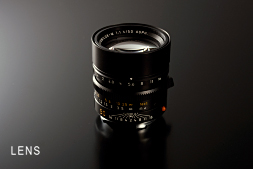
Voigtländer Nokton 50mm F1.5 Aspherical VM
A rangefinder shooter looks into the bright frame and presses the shutter button with soul. He or she wants to capture the scene around them freely without exaggeration. For such rangefinder fans, 35mm and 50mm are essential focal lengths. Speaking of one example of large-diameter lenses faster than F2, there’re four generations of the Leica Summilux F1.4 since the first one released in 1959. And, there’re many users of Carl Zeiss Sonnar lenses including the C Sonnar T* 1,5/50ZM. I’m sure they keep talking about the unique renditions for hours. The Nokton 50mm F1.5 Aspherical is one of such lenses. The first generation was released as a screw-mount lens in 1999 and was highly rated for its high resolution and delicate rendition. And in 2013, it was upgraded with an improved coating to be compatible with digital rangefinders like the Leica M and other mirrorless cameras. In addition, it was re-styled as a VM mount lens. Now, let’s explore the image quality.
( Photography / Text : T.Takahashi )



The three images above were shot wide open. The 3D quality isn’t dynamic, but the focal peak is extremely sharp. The natural front bokeh and back bokeh worked to clearly separate the focal plane. I’m also impressed with the texture expression of the tiles shinning dully and the wood grain of the handrail.

The white pottery pop out through the window glasses, presumably because of the soft bokeh of the reflected trees as well. The rendition of a gentle scene like this also demonstrates the high quality of this lens.

The rendition is tasty. The paper-framed lamp giving off a soft light is clearly separated because of the way the lens defocused the paper screen mildly transmitting the light as well as the garden stones and trees in the background.

Stopped down slightly to F2.4. The resolution of ropes placed around the trees and leaves is amazing. And, the slight and sweet falloff worked to emphasize the ropes (called yukizuri).

The minimum focus distance is 70cm, which is close enough for a rangefinder lens. As long as you don’t shoot tabletop, it’s no problem. I got close to the red maple leaf floating on the water. This is what a rangefinder shooter calls macro photography. :)

I opened up the aperture to shoot the shop curtains receiving strong sunshine. The exposure is a bit over, but it worked to express the wind and the clear air at the location.

The high clarity is another appeal of this lens. I used a high-key to take advantage of it. The soft transparent bokeh and the sharp focal peak dramatized the ordinary scene. Maybe you’ll want to keep shooting wide open once you get this lens.


This bar counter with good vibes was an attractive subject. The round bokeh reflected on the bottles and glasses is natural, demonstrating the good nature of the lens. The clearly separated cutlery inside the glasses also expresses the texture.

The emotive moment suddenly arrives on an ordinary scene. The question is, which lens do you mount on your camera to prepare for it. As they say "photography begins with 50mm and ends with 50mm," I guess many people choose 50mm. Then, what type of 50mm do you pick? This lens has superb image quality as I demonstrated. The bokeh unique to a large diameter lens is soft and elegant. The focal peak is very sharp wide open. And, it just doesn’t take excellent images. I feel it breathes life into the shots just like the legendary original lens had come back into existence. The aperture ring and the helicoid are in the right place of the hourglass-shape barrel which reminds me of the good old style, and I can feel that Cosina takes pride in the build quality as well. The brass silver version has a craftwork quality and the aluminum black version has a matter finish, which gives an unobtrusive look to your camera. Can’t choose the color? Maybe you can get both. :) It’s not reasonably priced, but you won’t regret. It feels nice to own and shoot. Among many 50mm lenses, it rivals current Leica 50mm lenses. And, it will become your favorite one.
( 2016.01.22 )

